Iguazu Falls
| Iguazu Falls | |
|---|---|
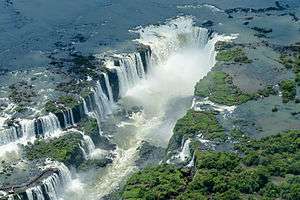 View of Iguazu Falls | |
| Location |
Argentina: Misiones Province Brazil: Paraná State |
| Coordinates | 25°41′12″S 54°26′41″W / 25.68667°S 54.44472°WCoordinates: 25°41′12″S 54°26′41″W / 25.68667°S 54.44472°W |
| Type | Cataract |
| Total height | 60–82 metres (197–269 ft)[1] |
| Number of drops | 275[1] |
| Longest drop | 82 metres (269 ft)[1] |
| Total width | 2.7 kilometres (1.7 mi)[1] |
| Watercourse | Iguazu River |
| Average flow rate | 1,756 m3/s (62,010 cu ft/s)[1] |
Iguazú Falls or Iguaçu Falls (Spanish: Cataratas del Iguazú [kataˈɾatas ðel iɣwaˈsu]; Guarani: Chororo Yguasu [ɕoɾoɾo ɨɣʷasu]; Portuguese: Cataratas do Iguaçu [kataˈɾatɐs du iɡwaˈsu]) are waterfalls of the Iguazu River on the border of the Argentine province of Misiones and the Brazilian state of Paraná. Together, they make up the largest waterfall system in the world.[2] The falls divide the river into the upper and lower Iguazu. The Iguazu River rises near the heart of the city of Curitiba. For most of its course, the river flows through Brazil; however, most of the falls are on the Argentine side. Below its confluence with the San Antonio River, the Iguazu River forms the boundary between Argentina and Brazil.
The name "Iguazú" comes from the Guarani or Tupi words "y" [ɨ], meaning "water", and "ûasú "[waˈsu], meaning "big".[3] Legend has it that a deity planned to marry a beautiful woman named Naipí, who fled with her mortal lover Tarobá in a canoe. In a rage, the deity sliced the river, creating the waterfalls and condemning the lovers to an eternal fall.[3] The first European to record the existence of the falls was the Spanish Conquistador Álvar Núñez Cabeza de Vaca in 1541.
Geology and Geography
The staircase character of the falls consists of a two-step waterfall formed by three layers of basalt. The steps are 35 and 40 m in height. The columnar basalt rock sequences are part of the 1000 m thick Serra Geral Formation within the Paleozoic-Mesozoic Paraná Basin. The tops of these sequences are characterized by 8-10 m of highly resistant vesicular basalt and the contact between these layers controls the shape of the falls. Headwater erosion rates are estimated at 1.4-2.1 cm/year.[4]
The Iguazu Falls are located where the Iguazu River tumbles over the edge of the Paraná Plateau, 23 kilometres (14 mi) upriver from the Iguazu's confluence with the Paraná River.[1] Numerous islands along the 2.7-kilometre-long (1.7 mi) edge divide the falls into many separate waterfalls and cataracts, varying between 60 and 82 m (197 and 269 ft) high. The number of these smaller waterfalls fluctuates from 150 to 300, depending on the water level. About half of the river's flow falls into a long and narrow chasm called the Devil's Throat (Garganta del Diablo in Spanish or Garganta do Diabo in Portuguese).[1]
The Devil's Throat canyon is 80-90 wide and 70-80 m deep. Left of this canyon, another part of the river forms 160-200 individual falls, which merge into a single front during flood stage. The largest falls are named San Martín, Adam and Eva, Penoni, and Bergano.[4]
About 900 m (2,950 ft) of the 2.7 km (1.7 mi) length does not have water flowing over it. The water of the lower Iguazu collects in a canyon that drains into the Paraná River, a short distance downstream from the Itaipu Dam. The junction of the water flows marks the border between Brazil, Argentina, and Paraguay. Some points in the cities of Foz do Iguaçu, Brazil, Puerto Iguazú, Argentina, and Ciudad del Este, Paraguay, have access to the Iguazu River, where the borders of all three nations may be seen, a popular tourist attraction for visitors to the three cities.
Distribution of the falls between Argentina and Brazil
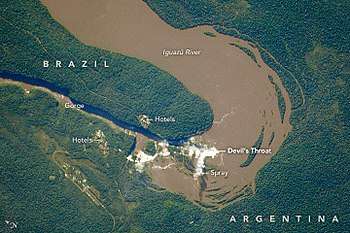
The Iguazu Falls are arranged in a way that resembles a reversed letter "J". The Argentina–Brazil border runs through the Devil's Throat. On the right bank is the Brazilian territory, which is home to more than 95% of the Iguazu River basin but has just over 20% of the jumps of these falls, and the left side jumps are Argentine, which makes up almost 80% of the falls.
Tourism
Two international airports are close to Iguazú Falls: the Argentine Cataratas del Iguazú International Airport (IGR) and the Brazilian Foz do Iguaçu International Airport (IGU). Bus and taxi services are available from and to the Airport-Falls. Aerolíneas Argentinas and LATAM Argentina[5] have direct flights from Buenos Aires to Iguazu International Airport Krause. Azul, GOL, and LATAM Brasil[6] offer services from main Brazilian cities to Foz do Iguaçu.
Access
.jpg)
The falls may be reached from two main towns, with one on either side of the falls: Foz do Iguaçu in Brazil and Puerto Iguazú in Argentina, as well as from Ciudad del Este, Paraguay, on the other side of the Paraná River from Foz do Iguaçu. The falls are shared by the Iguazú National Park (Argentina) and Iguaçu National Park (Brazil). The two parks were designated UNESCO World Heritage Sites in 1984 and 1987, respectively.[7]
The first proposal for a Brazilian national park aimed at providing a pristine environment to "future generations", just as "it had been created by God" and endowed with "all possible preservation, from the beautiful to the sublime, from the picturesque to the awesome" and "an unmatched flora" located in the "magnificent Iguaçú waterfalls". These were the words used by André Rebouças, an engineer, in his book Provinces of Paraná, Railways to Mato Grosso and Bolivia, which started up the campaign aimed at preserving the Iguaçu Falls in 1876. At this time, Yellowstone National Park in the U.S., the first national park in the world, was four years old.
On the Brazilian side, a walkway along the canyon has an extension to the lower base of Devil's Throat. Helicopter rides offering aerial views of the falls have been available from Brazil, but Argentina has prohibited such helicopter tours because of the adverse environmental impact on the flora and fauna of the falls.[8] From Foz do Iguaçu airport, the park may be reached by taking a taxi or bus to the entrance of the park. Their park has an entrance fee on both sides. Once inside, free and frequent buses are provided to various points within the park. The town of Foz do Iguaçu is about 20 km (12 mi) away, and the airport is between the park and the town. The Argentine access, across the forest, is by a Rainforest Ecological Train very similar to the one in Disney's Animal Kingdom. The train brings visitors to the entrance of Devil's Throat, as well as the upper and lower trails. The Paseo Garganta del Diablo is a 1 km-long (0.6 mi) trail that brings visitors directly over the falls of Devil's Throat, the highest and deepest of the falls. Other walkways allow access to the elongated stretch of falls across the forest on the Argentine side and to the boats that connect to San Martin Island. Also on the Argentine side, inflatable boat services take visitors very close to the falls.
The Brazilian transportation system aims at allowing the increase in the number of visitors, while reducing the adverse environmental impact, through an increase in the average number of passengers per vehicle inside the park. The new transportation system has 72-passenger capacity and panoramic-view, double-deck buses. The upper deck is open, which enables visitors a broad view of the flora and fauna during the trip to the falls. The bus combustion systems are in compliance with the CONAMA (phase IV) and EURO (phase II) emissions and noise requirements. The reduction in the number of vehicles, of noise levels, and speed, is enabling tourists to observe increasing numbers of wild animals along the route. Each bus has an exclusive paint scheme, representing some of the most common wild animals found in the Iguaçú National Park, including the spotted jaguars, butterflies, raccoons, prego monkeys, coral snakes, toucans, parrots, and yellow-breasted caimans.
Comparisons to other notable falls
Upon seeing Iguazu, the United States First Lady Eleanor Roosevelt reportedly exclaimed, "Poor Niagara!"[3] (which, at 50 m or 165 feet, are a third shorter). Often, Iguazu also is compared with Victoria Falls in Southern Africa, which separates Zambia and Zimbabwe. Iguazu is wider, but because it is split into roughly 275 distinct falls and large islands, Victoria has the largest curtain of water in the world, at more than 1,600 m (5,249 ft) wide and over 100 m (328 ft) in height (in low flow, Victoria is split into five by islands; in high flow it may be uninterrupted). The only wider falls are extremely large rapid-like falls, such as the Boyoma Falls (Stanley Falls).
With the flooding of the Guaíra Falls in 1982, Iguazu currently has the sixth-greatest average annual flow of any waterfall in the world, following number five Niagara, with an average rate of 1,746 m3/s (61,660 cu ft/s). Its maximum recorded flow was 45,700 m3/s (1,614,000 cu ft/s) in 9 June 2014.[9][10] By comparison, the average flow of Niagara Falls is 2,400 m3/s (85,000 cu ft/s), with a maximum recorded flow of 8,300 m3/s (293,000 cu ft/s).[11] The average flow at Victoria Falls is 1,088 m3/s (38,420 cu ft/s), with a maximum recorded flow of 7,100 m3/s (250,000 cu ft/s).[12]
Climate
The Iguazu Falls experience a humid subtropical climate (Cfa, according to the Köppen climate classification) with abundant precipitation and high temperatures year-round. During the summer of 2006, a severe drought caused the Iguazu River to become diminished, reducing the amount of water flowing over the falls to 300 cubic metres per second (11,000 cu ft/s) until early December. This was unusual, as dry periods normally last only a few weeks.[13]
| Climate data for Iguazu Falls (Foz do Iguacu), Brazil | |||||||||||||
|---|---|---|---|---|---|---|---|---|---|---|---|---|---|
| Month | Jan | Feb | Mar | Apr | May | Jun | Jul | Aug | Sep | Oct | Nov | Dec | Year |
| Record high °C (°F) | 40.0 (104) |
40.0 (104) |
38.8 (101.8) |
36.8 (98.2) |
36.0 (96.8) |
32.0 (89.6) |
31.3 (88.3) |
35.0 (95) |
36.8 (98.2) |
39.0 (102.2) |
38.6 (101.5) |
39.4 (102.9) |
40.0 (104) |
| Average high °C (°F) | 33.0 (91.4) |
32.6 (90.7) |
31.1 (88) |
28.2 (82.8) |
25.2 (77.4) |
23.1 (73.6) |
23.7 (74.7) |
25.3 (77.5) |
26.9 (80.4) |
28.8 (83.8) |
31.0 (87.8) |
32.6 (90.7) |
28.5 (83.3) |
| Daily mean °C (°F) | 25.5 (77.9) |
25.4 (77.7) |
23.8 (74.8) |
20.8 (69.4) |
17.7 (63.9) |
15.8 (60.4) |
15.7 (60.3) |
17.5 (63.5) |
19.0 (66.2) |
21.4 (70.5) |
23.1 (73.6) |
25.1 (77.2) |
20.9 (69.6) |
| Average low °C (°F) | 19.6 (67.3) |
20.0 (68) |
18.4 (65.1) |
15.4 (59.7) |
12.2 (54) |
10.4 (50.7) |
9.7 (49.5) |
11.3 (52.3) |
13.5 (56.3) |
15.3 (59.5) |
16.5 (61.7) |
18.6 (65.5) |
15.1 (59.2) |
| Record low °C (°F) | 9.2 (48.6) |
6.8 (44.2) |
5.2 (41.4) |
3.0 (37.4) |
−1.0 (30.2) |
−3.1 (26.4) |
−4.2 (24.4) |
0.0 (32) |
1.0 (33.8) |
5.0 (41) |
6.3 (43.3) |
3.8 (38.8) |
−4.2 (24.4) |
| Average precipitation mm (inches) | 196.0 (7.717) |
180.1 (7.091) |
174.8 (6.882) |
151.0 (5.945) |
127.6 (5.024) |
138.3 (5.445) |
84.4 (3.323) |
107.4 (4.228) |
146.6 (5.772) |
219.8 (8.654) |
153.7 (6.051) |
189.0 (7.441) |
1,868.7 (73.571) |
| Average precipitation days (≥ 1.0 mm) | 9 | 9 | 8 | 8 | 6 | 8 | 6 | 8 | 8 | 9 | 7 | 9 | 95 |
| Average relative humidity (%) | 77 | 80 | 82 | 85 | 86 | 85 | 83 | 80 | 79 | 78 | 75 | 74 | 80.3 |
| Mean monthly sunshine hours | 230.5 | 196.3 | 209.9 | 193.6 | 180.8 | 151.2 | 168.7 | 157.9 | 146.4 | 195.6 | 231.4 | 232.3 | 2,294.6 |
| Source: INMET[14] | |||||||||||||
Gallery
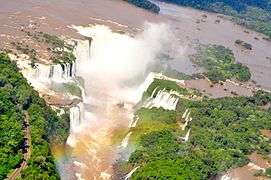 Aerial view of the Iguazu Falls from a helicopter
Aerial view of the Iguazu Falls from a helicopter- Iguazu Falls from the Argentine side
.jpg) Iguazu Falls from the Brazilian side
Iguazu Falls from the Brazilian side- Aerial view, from the Argentine side
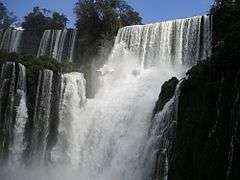 Bosetti waterfall
Bosetti waterfall Falls and Brazilian tourist complex
Falls and Brazilian tourist complex Devil's Throat. View From Iguazu National Park, Argentina.
Devil's Throat. View From Iguazu National Park, Argentina.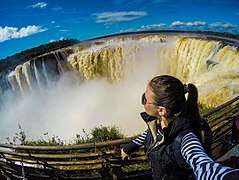 Devil's Throat. View From Iguazu National Park, Argentina.
Devil's Throat. View From Iguazu National Park, Argentina.

Portrayals in film
Iguazu Falls have been featured in several TV shows and movies,[15] including:
- Le cascate dell'Ignazu (1907, Ambrosio. Shot by Roberto Omegna, 135 meters)
- Z Argentiny do Mexika (1954)
- Curucu, Beast of the Amazon (1956)
- Moonraker (1979)
- The Mission (1986)
- The Country Bears Down Under (1990)
- Baraka (1992)
- Extermineitors IV: Como hermanos gemelos (1992)
- O Trem Caipira (1994)
- Tummy (1995)
- Happy Together (1997)
- Mr. Magoo (1997)
- Miami Vice (2006)
- In the Hands of the Gods (2007)
- Indiana Jones and the Kingdom of the Crystal Skull (2008)
- OSS 117: Rio ne répond plus (2009)
- Salve Geral (2009)
- Survivor: Tocantins (2009)
- Operação X (2011)
- Captain America: Civil War (2016)
- If Cats Disappeared From the World (2016)
- A Fantastic Woman (2017)
- Black Panther (2018)
See also
References
- 1 2 3 4 5 6 7 "Iguaçu Falls". Encyclopædia Britannica (Encyclopædia Britannica Online Library ed.). 2011. Retrieved 15 April 2011.
- ↑ Dominic Couzens (2008), Top 100 Birding Sites of the World, University of California Press, p. 228, ISBN 978-0-52-025932-4
- 1 2 3 Bonnie Hamre. "Iguazu Falls". About.com Travel.
- 1 2 Stevaux, Jose; Latrubesse, Edgardo (2010). Migon, Piotr, ed. Iguazu Falls: A History of Differential Fluvial Incision, in Geomorphological Landscapes of the World. Springer. pp. 101–109. ISBN 9789048130542.
- ↑ "Travel to Puerto Iguazu". LATAM. Retrieved 19 January 2017.
- ↑ "Travel to Foz Do Iguaçu". LATAM. Retrieved 19 January 2017.
- ↑ UNESCO World Heritage Centre. "UNESCO World Heritage Centre – World Heritage List". unesco.org.
- ↑ "IguazuFalls.com Helicopter Ride". IguazuFalls.com. Retrieved 23 January 2017.
- ↑ Fabiula Wurmeister (9 June 2014). "Chuvas fazem vazão das Cataratas bater recorde e Itaipu abrir vertedouro". globo.com notícias. Retrieved 11 June 2014.
- ↑ "Dia histórico nas Cataratas do Iguaçu". Cataratas do Iguaçu S.A. 10 June 2014. Retrieved 11 June 2014.
- ↑ "Niagara Falls". World Waterfall Database. Retrieved 2 December 2010.
- ↑ "Victoria Falls". World Waterfall Database. Retrieved 2 December 2010.
- ↑ "The Kerala Articles". keralaarticles.blogspot.com.
- ↑ "NORMAIS CLIMATOLÓGICAS DO BRASIL 1961–1990" (in Portuguese). Instituto Nacional de Meteorologia. Retrieved 22 September 2014.
- ↑ IMDb. "Most Popular Titles With Location Matching "Foz do Iguaçu, Paraná, Brazil"". Retrieved 30 October 2010.
External links
| Wikimedia Commons has media related to Iguaçu Falls. |
| Wikivoyage has a travel guide for Iguaçu Falls. |
- Foz do Iguaçu (Brazilian government site, in Portuguese)
- Copel Monitoramento Hydrológico (Iguazu River flow rate measurements; leftmost green dot gives flow rate at Hotel Cataratas)
- Iguazu Falls – Information, Hotels, Activities
- Iguazu Falls Travel Information (English website)
- Greatest Places: Iguazu Falls page
- Iguazu Falls at UNESCO World Heritage Centre site
- Iguazu Falls facts
- "Iguazu Falls". World Waterfall Database.
- https://vimeo.com/44873371
